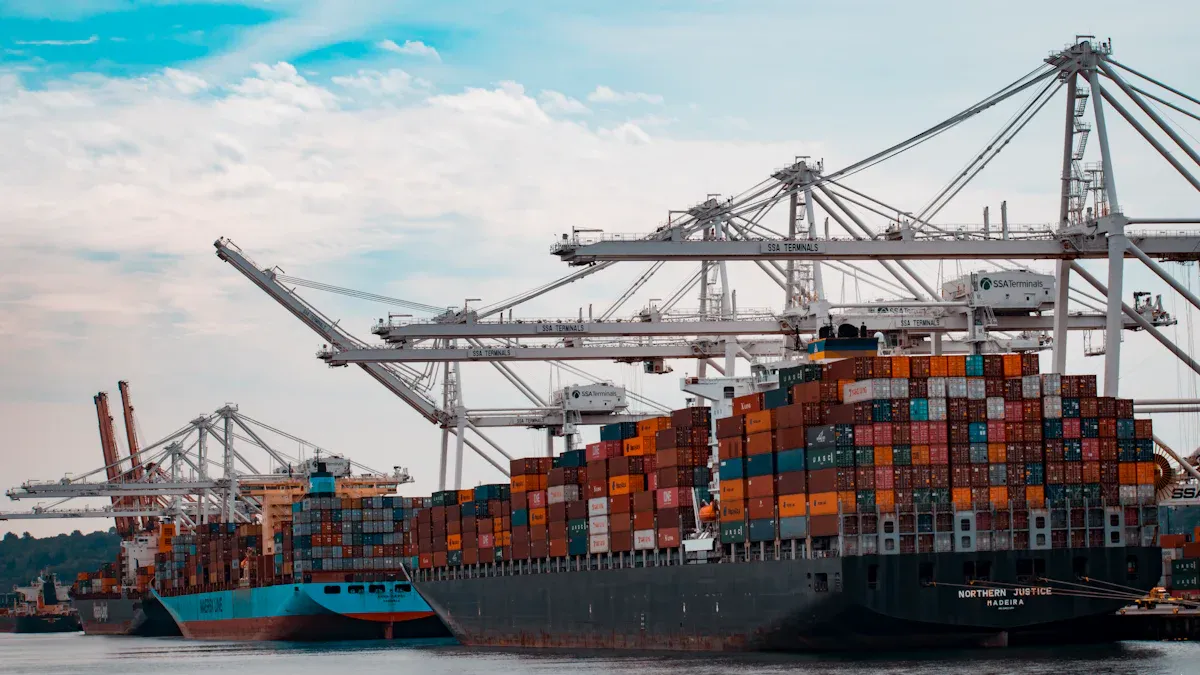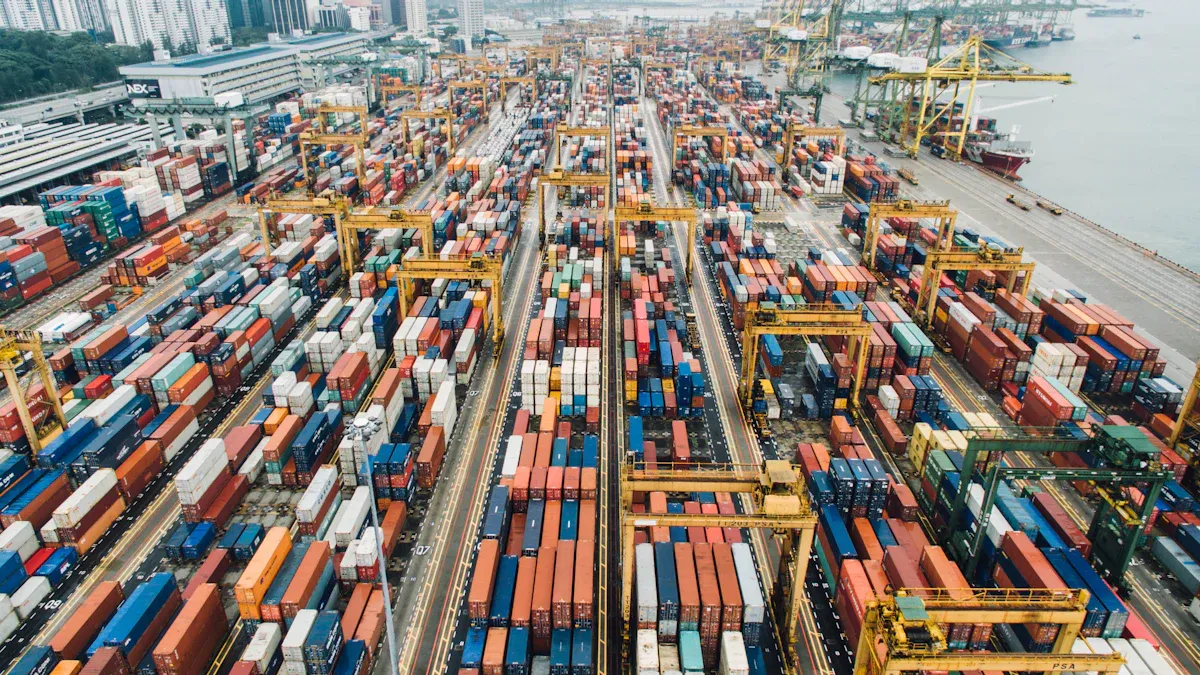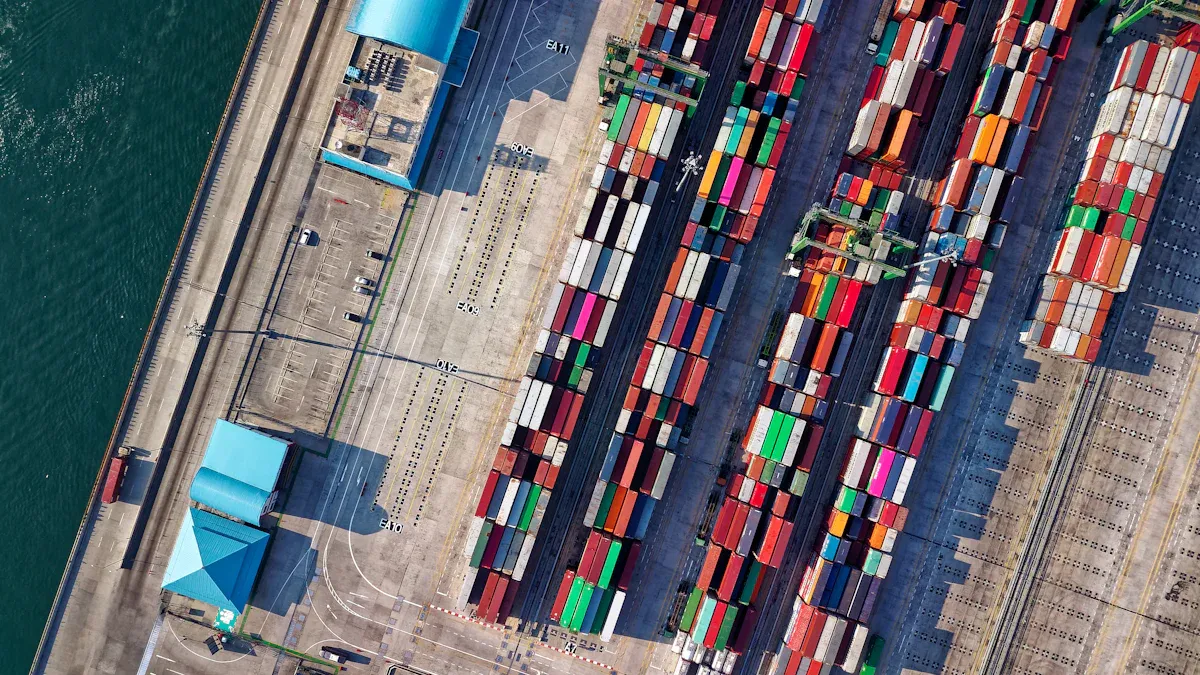Essential Tips for Managing Shipments and Tracking Cargo

Efficient shipment management is important for your business. Today, supply chains have more than 20 groups and about 40 documents for each international shipping. Delays make companies lose $300 billion every year.
You need good shipping and Cargo Tracking to keep your profits safe and make customers trust you.
Statistic | Value | Explanation |
|---|---|---|
Customers prioritizing speed of delivery | 70.8% | Fast shipping is very important. |
Customers preferring parcel tracking systems | 37.6% | Real-time Cargo Tracking helps people feel sure. |
Key Takeaways
Use smart technology like JUSDA’s platform and transportation management systems. These tools help you track shipments in real time. They also help you plan routes better. This saves money and makes deliveries faster. It also keeps customers happy.
Work closely with reliable carriers and partners. Share updates and use clear communication tools. This helps you avoid delays and reduce mistakes. It also builds trust in your shipping process.
Check your shipping process, packing methods, and performance metrics often. Look for ways to make things better. Using new technology and careful planning helps. This leads to faster, safer, and cheaper logistics.
Technology Tools

JUSDA Platform
You need good technology to handle freight and logistics. The JUSDA Platform is a full supply chain management tool. It links all your logistics, like shipping and warehouse management. You can see every shipment and cargo tracking event as it happens. JUSDA uses IoT, AI, and cloud computing to gather sensor data. This includes temperature, humidity, and pressure. The data lets you check cargo and equipment at each step. Smart scheduling models help you plan logistics better. These models make transportation faster and save money.
JUSDA’s platform uses automation for demand forecasting, delivery scheduling, and customs work. You can see inventory levels right away and get alerts when you need more stock. Automation like this helps you avoid delays and keeps logistics running well.
JUSDA’s tracking system lets you follow shipments by air, land, sea, and rail. You can work with many carriers and see customs steps clearly. This makes freight management better and supply chain management stronger.
Real-time sensor data helps keep things safe and efficient.
AI predicts when vessels will arrive, so you avoid crowded ports.
Smart inventory systems use IoT for updates and better layouts.
Data on cargo handling times shows slow spots and ways to improve.
Transportation Management Systems (TMS)
A transportation management system is important for good logistics. TMS helps you plan, do, and improve shipping. It gives you tools for route planning, picking carriers, and combining shipments. You can track shipments live and use data to make smart choices.
The truck market is growing quickly. Using TMS helps you stay ahead by using resources well and cutting costs. Live tracking and route planning make shipments more reliable and faster. You also get better inventory turnover, so you sell and restock faster.
A study says retail companies spend about 4.5% of sales on transportation. TMS helps lower this by making routes better and combining shipments. You can also get better deals with carriers.
Metric | Description | Strategies Enabled by TMS and Improvements |
|---|---|---|
Part of sales spent on transportation | Route planning, shipment combining, carrier deals | |
Transportation spend per unit | Cost to move one product unit | More shipment density, better packaging, route planning |
Carrier performance metrics | On-time rate, damage rate, transit time | Carrier scorecards, feedback, using other carriers |
Inventory turnover | How often inventory is sold and replaced | Just-in-time, better forecasting, vendor-managed inventory |
Warehouse capacity utilization | How much warehouse space is used | Layout planning, WMS, vertical storage |
Order picking and packing efficiency | Speed and accuracy of order filling | WMS, better layout, picking tech, quality checks |
You can use TMS with warehouse management systems for even better logistics. This gives you strong tracking and helps you track shipments well. Many tasks can be automated, saving time and cutting mistakes.
Real-Time Tracking
Real-time tracking changes how you handle freight and logistics. You get updates on where each shipment is and its status. This tracking gives you live visibility and helps you act fast.
With real-time tracking, supply chain costs can drop by 22%. Service levels go up by 28%, and fuel costs can fall by 15%. You meet customer needs for fast delivery and talk to them better.
Impact Area | Statistic/Result | Description/Effect on Cargo Visibility and Timely Deliveries |
|---|---|---|
Supply Chain Cost Reduction | 22% decrease | Live data saves money by making better choices |
Service Level Increase | 28% increase | Faster, smarter choices make deliveries more reliable |
Fuel Cost Savings | Up to 15% reduction | Better routes and use of trucks save fuel and time |
Customer Delivery Expectation | 52% want 2-3 day delivery | Real-time tracking helps manage delays and meet needs |
Customer Communication Improvement | Better communication | Live updates keep customers happy and informed |
You can use data from real-time tracking to pick the best routes and carriers. This helps you deliver on time and track cargo better.
Real-time tracking gives you full visibility of shipments.
You can plan vessel schedules and cut down port wait times.
You save money by skipping manual tracking and late fees.
Accurate ETAs and quick updates make customers happier.
Inventory management is better with constant updates and less waste.
Data helps you make fast choices and manage freight better.
Tip: Use automation and real-time tracking together for the best results in logistics. You will get faster deliveries, lower costs, and happier customers.
Planning & Forecasting
Route Optimization
You can make freight management better with route optimization tools. These tools help you choose the best way for each shipment. You save time and money by skipping traffic and bad weather. You also avoid busy delivery times. Many big companies use route optimization to work better. FedEx, UPS, and Addison Lee have all improved with smart routing systems.
Company | Route Optimization Implementation | Impact on Shipping Time and Costs |
|---|---|---|
FedEx | Used algorithms considering traffic, weather, and delivery windows | Achieved 10% reduction in fuel costs within the first year, improving delivery efficiency and lowering operational expenses |
UPS | Adopted ORION system analyzing delivery paths and logistics | Reduced over 10 million miles driven annually, saving ~$400 million in fuel and labor costs per year; also reduced greenhouse gas emissions |
Addison Lee | Optimized routes using real-time traffic data and demand forecasting | Decreased average delivery times by 20%, enhancing customer satisfaction and financial performance |
JUSDA’s platform uses smart models to plan routes for shipments. You can watch each delivery and change plans if there are problems. This makes things run smoother and helps freight management.
Demand Forecasting
Good demand forecasting helps you plan shipments and manage inventory. You use data and smart models to guess what customers will want. This cuts down on waste and keeps freight management working well. Forecasting models look at old sales, prices, and trends. They help you see patterns and plan better.
You can check forecast accuracy with numbers like forecast error, bias, and MAPE. Lower errors mean you plan better and have less extra stock. Many companies now use machine learning to make forecasting better. These tools find patterns people might not see. When you share forecasts with suppliers, you work together better and plan shipments well. JUSDA’s forecasting tools help you keep the right amount of inventory and work better. This leads to a stronger supply chain and more reliable freight management.
Tip: Use both route optimization and demand forecasting together. You will get faster deliveries, spend less money, and manage shipments better.
Carrier & Partner Collaboration
Reliable Carriers
You need reliable carriers to keep things running well. Good carriers help you avoid delays and keep shipments moving. You can check if a carrier is reliable by looking at key numbers. These numbers include on-time delivery, transit time, and claims ratio. Ask carriers for their past records on these numbers. Customer stories and case studies show how well a carrier does. Reading reviews from other people gives you a fair view.
Make sure carriers have all the right licenses, permits, and insurance.
Check their performance often to find risks and keep service good.
Use real-time tracking to see how carriers move your shipments.
Build strong relationships with carriers for better teamwork.
Performance Metric | Description/Use Case |
|---|---|
Transit time | Shows how long shipments take to get there. |
On-time delivery rate | Tells what percent of shipments arrive on time. |
Damage rate | Tracks how often shipments get damaged. |
Billing accuracy | Checks if bills and charges are right. |
Claims ratio | Compares claims made to shipments handled. |
Customer satisfaction | Collects feedback and ratings from customers. |
When you track these numbers, you can make carriers do better and improve logistics. One customer said, “Carrier performance data helps us understand our delivery process. It makes us think differently about picking carriers and helps us talk to them.”
Communication Channels
Good communication helps you work better with carriers and partners. You can use digital tools to share updates and schedules right away. This helps stop mistakes like missed times or wrong load details. When you use one main platform, you make logistics easier and have fewer errors.
Fewer mistakes mean fewer missed deliveries and less crowding in the yard.
Real-time updates help you change plans fast when there are delays.
Smoother handoffs between carriers and dock staff make things better.
Surveys and feedback from carriers show how well you talk to each other.
JUSDA’s way uses digital tools to connect everyone in the supply chain. This leads to better logistics, happier customers, and a stronger experience. You can plan work better, cut down on overtime, and move more shipments. Good customer communication keeps everyone in the loop and builds trust in your shipping.
Packaging & Space
Cost-Effective Packing
You can make logistics better by packing smart. Good packing keeps your goods safe and saves space. Picking the right box size and materials lowers shipping costs. Using the same packaging helps stack items easily in containers. This makes space use better and keeps products safe when moving.
Use strong but light materials for packing. These keep cargo safe without making it heavy. Lighter cargo means you spend less on fuel. Packing things close together stops them from moving. This helps avoid damage and makes inventory easier to manage. Packing tools help you measure and cut materials fast. This saves time and helps manage logistics better.
Tip: Check your packing process often. Even small changes can save money and make logistics work better.
Load Efficiency
Load efficiency is very important for good logistics. When you plan loads well, you use all the space in trucks or containers. This means you need fewer trips, which saves money and time. You also help the planet by using less fuel.
Load planning software helps you fit more cargo in each container.
Using the same packaging and stacking up saves space.
Sending more goods in fewer containers is called shipment consolidation.
Fewer empty return trips save money and help logistics.
Better load efficiency gives you many benefits. You spend less and have more money to use. Deliveries are faster, and logistics work better. Smart load planning makes your logistics strong and reliable.
Note: Load efficiency helps you use cargo space well and save money. It also helps you reach your logistics goals.
Compliance & Documentation
Shipping Process
You need a strong shipping process to keep your cargo moving smoothly. Each step in the shipping process matters. You must plan, pick the right carrier, and track your shipment. Good documentation helps you avoid mistakes and delays. If you miss a document, your shipment can get stuck. Real-time tracking tools, like those used by JUSDA, give you updates at every stage. This helps you see where your cargo is and when it will arrive. Research shows that 83% of customers want to track their shipments. Accurate data entry in the shipping process keeps your records correct. You can make better choices and avoid costly errors. When you follow each part of the shipping process, you build trust with your customers and keep your business running well.
Tip: Always double-check your shipping documents before sending your cargo. This simple step can save you time and money.
Customs & Regulations
Customs rules can change from country to country. You must follow each rule to keep your shipping process on track. Customs agencies look at your paperwork to make sure everything is legal and safe. They use systems like the Union Customs Code and WCO SAFE Framework to guide their work. These rules help keep trade safe and smooth. JUSDA’s customs coordination helps you handle these steps with ease. The company uses smart technology to collect and check data for each shipment. This makes the shipping process faster and more reliable. When you follow customs rules, you avoid fines and delays. You also help your cargo move quickly across borders.
Customs Task | Why It Matters |
|---|---|
Document Checking | Stops delays and fines |
Risk Management | Keeps shipments safe |
Data Collection | Speeds up the shipping process |
Cargo Tracking Visibility

Efficient Shipment Tracking
You need good shipment tracking to keep freight management strong. Cargo tracking tools let you see each step of shipping. You get updates about where your shipment is and its status. This helps you find problems early and fix them fast. JUSDA’s platform gives you real-time tracking and full visibility. You can watch your cargo move from the warehouse to the customer’s door. This kind of tracking helps you make smart choices and stay on schedule.
Efficient shipment tracking systems send real-time data to your team. You get alerts if routes change or there are delays. This means you can fix problems quickly. You also save money by avoiding emergency fixes and late fees. Customers trust you more when you give clear updates. Good freight management needs this kind of visibility.
Proactive Updates
Proactive exception management is important for modern freight management. You do not wait for problems to happen. Instead, you use tracking to spot issues before they get worse. JUSDA’s solutions send alerts about delays, weather, or customs problems. You can act fast and keep shipping smooth.
Proactive exception management also helps you talk to customers. You send them updates about their shipment. They know when to expect their cargo. This builds trust and keeps customers happy. When you use cargo tracking and efficient shipment tracking together, your freight management is reliable. You get fewer surprises and better results for every customer.
Continuous Improvement
Performance Metrics
You need to watch the right numbers to keep logistics strong. Performance metrics show how well shipment management works. These numbers help you find places to get better and see what is already good. You can use them to check service reliability, customer happiness, and how well things run. Watching these numbers helps you make smarter choices for logistics.
Here is a table that lists key performance metrics and trends in logistics:
Performance Metric / Improvement Trend | Description / Impact |
|---|---|
Service Reliability | Deliveries are on time and cargo tracking is simple. |
Customer Satisfaction | Focus on what customers want and make things better. |
Operational Efficiency | Automation helps plan and use resources well. |
Cost Control | Digital tools help lower work and running costs. |
Real-time Information Availability | IoT and AI give live tracking and updates. |
Cooperation Between Partners | Working together makes logistics smoother. |
Automation Examples | Cranes, AGVs, and drones help with logistics. |
Digital Platforms | Digital systems make deals and tasks faster. |
Labor Strategy Evolution | More focus on managing and programming jobs. |
Tip: Check your logistics numbers often. This helps you find problems early and keep things working well.
Adopting New Tech
You can make logistics better by using new technology. Automation and digital platforms help you work faster and with fewer mistakes. IoT sensors, AI, and big data give real-time updates on shipments. These tools help you track cargo, plan routes, and manage inventory better.
Many companies now use cranes, guided vehicles, and drones for logistics. These tools mean less manual work and safer jobs. Digital platforms like blockchain make deals safer and quicker. When you use new tech, you spend less on workers and get better results.
Always look for new ways to improve logistics. Try new tools, teach your team, and stay flexible. This helps you keep up in the fast-changing world of logistics.

JUSDA Solutions
To provide you with professional solutions and quotations.
You can improve shipping by using smart tools, working closely with partners, and checking your process often. Good shipping needs clear tracking and strong teamwork. Try new technology to make shipping faster and safer. Explore JUSDA’s platform to keep your shipping on track and meet your goals.
See Also
Proven Strategies For Managing Risks In Supply Chains
Step-By-Step Guide To Successful Supply Chain Risk Control
Key Reasons To Join The Best Logistics Webinar Sessions
